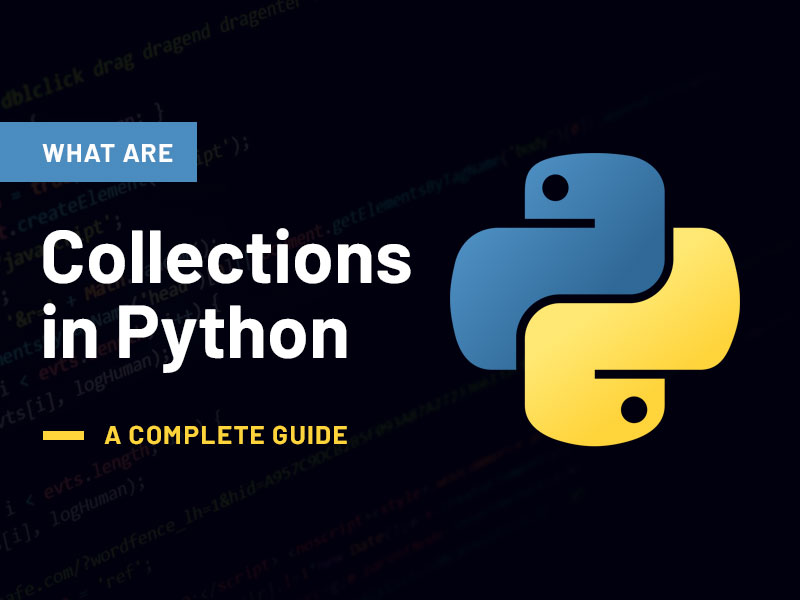Collections in Python are groups of data types that are similar in computer programming. It may be helpful to organize and manage related items using these unit classes. The data structures used in collections make it possible to manage huge volumes of data effectively. In Python, there is a wide variety of container types available in the collection module.
A variety of items can be stored in containers, and they can be re-created. There are many different types of containers, such as tuples, lists, dictionaries, and more. Let’s take a closer look at the collections module in this article!
What is a module in Python
Python modules contain Python definitions and statements and is commonly used in python programming. It is possible to define functions, classes, and variables in a module. It is also possible to include runnable code in a module. Organizing related code into modules makes it easier to understand and use. This also improves the logical organization of the code. Components of the module include:
- Class definitions and implementations,
- The variables, as well as
- A program’s functions that can be called from another program.
Example:
Let’s create a simple calculator.py in which we define two functions, one multiply and another divide.
defmultiply(x, y):
return (x*y)
defdivide(x, y):
return (x/y)
We are now importing the calc we created earlier in order to multiply data.
print(calculator.multiply(5, 4))
Output:
20
Advantages of Python Module
Python modules have the following advantages:
Simplicity:
Modules usually focus on one relatively small part of a larger problem, rather than the entire problem. You’ll have a shorter problem domain to deal with if you’re working on a single module. It simplifies development and makes it less error-prone.
Maintainability:
Different problem domains are typically separated logically by modules. Modifications to one module are less likely to affect other modules if modules are written to minimize interdependencies. Even if you don’t know anything about the application outside the module, you may be able to make changes to it. In this way, a large application can be developed collaboratively by many programmers.
Reusability:
Module functionality can be reused within the application (via an appropriate interface) by other parts. In this way, duplication of code is avoided.
Scoping:
Program modules typically define their own namespace, which prevents collisions between identifiers in different parts of the program.
What is a collection in Python?
A collection in Python is a data structure that can hold multiple items in a single variable. Some examples of built-in collection types in Python include lists, tuples, sets, and dictionaries. These types are all implemented as classes in Python, and provide methods that can be used to add, remove, and access the items in the collection. The items in a collection can be of any type, and a collection can hold items of different types.
- List is a collection which is ordered and changeable. Allows duplicate members.
- Tuple is a collection which is ordered and unchangeable. Allows duplicate members.
- Set is a collection which is unordered and unindexed. No duplicate members.
- Dictionaries is a collection which is unordered, changeable and indexed. No duplicate members.
Types of Collections in Python
There are several built-in collection types in Python, including:
- Lists: Lists are ordered and changeable collections of items. They can contain items of any type and can have duplicate values. Lists are represented by square brackets [] and their items are separated by commas.
- Tuples: Tuples are similar to lists, but they are ordered and unchangeable. They can contain items of any type and can have duplicate values. Tuples are represented by parentheses () and their items are separated by commas.
- Sets: Sets are unordered collections of unique items. They are useful for performing mathematical set operations like union, intersection, and difference. Sets are represented by curly braces {} and their items are separated by commas.
- Dictionaries: Dictionaries are collections of key-value pairs. They are unordered and changeable, and can have keys of any immutable type and values of any type. Dictionaries are represented by curly braces {} and their key-value pairs are separated by colons.
- Strings: Python strings are sequences of characters. It is also considered as collection of characters.
- Arrays: Arrays are collection of items of same type. They are similar to lists, but are more efficient for certain types of operations. They are implemented as classes in Python, and provide methods that can be used to add, remove, and access the items in the collection.
Use Cases of Python Collections
Python collections have many different use cases, some examples include:
- Storing and manipulating data: Collections can be used to store large amounts of data and perform operations on that data, such as sorting, filtering, and aggregating.
- Organizing and structuring data: Collections can be used to organize and structure data in a logical and meaningful way, making it easier to access and manipulate.
- Implementing data structures: Collections can be used to implement various data structures, such as stacks, queues, and linked lists.
- Building data pipelines: Collections can be used to build data pipelines that allow you to transform, filter, and aggregate data as it flows through the pipeline.
- Creating Graphs and Trees: Lists, Tuples, Dictionaries and sets can be used to create Graphs and Trees.
- Machine learning: Collections can be used to store and manipulate data used in machine learning algorithms, such as training data sets and model parameters.
- Web development: Collections can be used to store and manipulate data used in web development, such as session data, user information, and form data.
- Database management: Collections can be used to store and manipulate data used in database management, such as query results and database schema information.
What is a collection module in Python?
Python’s Collections module provides containers for collecting data. Some of them are already familiar to you. Python includes in-built collections like dictionaries, tuples, sets, lists, etc.
A collection not only allows you to collect data, but also to iterate over it and explore its data. A number of additional modules have other types of useful data structures, just like many of the in-built collections. Among the modules, there is one called Collection. Using this module, users can extend the functionality of Python data structures (collections).
Different types of collection modules in Python
Collection modules can be divided into the following types:
1. namedtuple
Every value in the tuple will be given a unique name using this function. There is no need for index values anymore. Named tuples make retrieving these values much easier because index values don’t need to be remembered.
Syntax:
Example:
Employee_record = (‘Muthu’, 25, ‘Male’)
print(Employee_record)
Output:
(‘Muthu’, 25, ‘Male’)
2. deque
Python lists can be replaced by deque objects, which are much faster. Each side of the deque supports thread-safe and memory-efficient operations. There are some methods in deque that are shared with lists as well as some that are unique. Here are a few useful ones:
- append(n): Inserts element “n” on the right side of the deque
- appendleft(n): Inserts a new element on the deque’s left side
- count(e): Returns the number of times “e” occurs
- extend(iterable): Expends the deque by appending the elements from iterable from right to left
- extendleft(iterable): From the left, it extends the deque by appending the elements from the iterable
- insert( i , e ): Adds element “e” to position “i”
- reverse(): Reverses the deque elements
Syntax:
Example:
list = [“H”,”e”,”l”,”l”,”o”]
Letter_words = deque(list)
print(Letter_words)
Output:
deque([‘H’, ‘e’, ‘l’, ‘l’, ‘o’])
3. The defaultdict
By default, defaultdict behaves exactly like a Python dictionary except when trying to access a non-existent key, it does not throw KeyError. Rather, it initializes the key with the data type element you provide as an argument at the time of defaultdict creation. This data type is called default_factory.
Syntax:
Example:
x = defaultdict(int)
x[1] = ‘muthu’
x[2] = ‘annamalai’
print(x[3])
Output:
0 (Instead of throwing the key error)
4. ChainMap
In ChainMap, many dictionaries are encapsulated and returned as a list. Whenever both dictionaries contain many pairs of keys and values, ChainMap creates one list.
Syntax:
Example:
x = {‘Muthu’: 20, ‘Annamalai’: 25}
y = {‘Nanda’: 18, ‘Kumar’: 23}
z = {‘Jeevan’: 15, ‘Akshay’: 24}
d = ChainMap(x,y,z)
print(d)
Output:
ChainMap({‘Muthu’: 20, ‘Annamalai’: 25}, {‘Nanda’: 18, ‘Kumar’: 23}, {‘Jeevan’: 15, ‘Akshay’: 24})
5. Counter
Counters are subclasses of dictionaries. It is used as an unordered dictionary to keep count of the elements in an iterable, where the key represents an element and the value represents its count. This counter has 3 additional functions, which are:
- Elements
- Most_common
- Subtract
1.The element() Function
A Counter object’s items can be obtained with the elements() function. Upon calling this function, you will receive a list of all the elements in the counter object
2. The most_common() Function
An unordered dictionary is returned by the Counter() function. The Counter object can be sorted by the number of counts in each element using the most_common() function.
3. The subtract() Function
Subtract() deducts the elements count from an iterable (list) or a mapping (dictionary).
Syntax:
Example:
print(Counter([‘Muthu’, ‘Annamalai’, ‘Muthu’, ‘Nanda’, ‘Annamalai’, ‘Rakesh’]))
print(Counter({‘Muthu’: 2, ‘Annamalai’:2 , ‘Nanda’: 1, ‘Rakesh’: 1}))
print(Counter(Muthu= 2, Annamalai= 2 , Nanda= 1, Rakesh= 1))
Output:
Counter({‘Muthu’: 2, ‘Annamalai’: 2, ‘Nanda’: 1, ‘Rakesh’: 1})
Counter({‘Muthu’: 2, ‘Annamalai’: 2, ‘Nanda’: 1, ‘Rakesh’: 1})
Counter({‘Muthu’: 2, ‘Annamalai’: 2, ‘Nanda’: 1, ‘Rakesh’: 1})
6. Ordered Dicts
OrderedDicts are also subclasses of dictionary, but unlike dictionary, they keep track of the order in which keys are inserted. In logic, changing a key’s value will not change its placement due to the series of entries.
Syntax:
Example:
Key = collections.OrderedDict()
Key[‘Muthu’] = 20
Key[‘Annamalai’] = 15
Key[‘Rakesh’] = 25
Key[‘Meghana’] = 35
fori,jinKey.items():
print (i,j)
Output:
Muthu 20
Annamalai 15
Rakesh 25
Meghana 35
7. User Dict
The dictionaries are encapsulated in this class. It is necessary to create this class in order to subclass from dict. In order to make the dictionary more accessible, we have added it as a property to the class.
It’s fun to play with this class, which behaves like a dictionary. The UserDict class’s data field can be used to access the instance’s data using a standard dictionary. Original data is not maintained in order to be utilized for other purposes.
Syntax:
Example:
data = {‘Muthu’:20,
‘Annamalai’: 30,
‘Rakesh’: 28}
x = UserDict(data)
print(x.data)
Output:
{‘Muthu’:20, ‘Annamalai’: 30, ‘Rakesh’: 28}
8. UserList
UserList acts as a wrapper class around list-objects. It is useful for adding functionality to lists. It makes working with the dictionary easier.
Syntax:
Example:
data = [‘Muthu’,’Annamalai’,’Rakesh’]
x = UserList(data)
print(x.data)
Output:
[‘Muthu’,’Annamalai’,’Rakesh’]
Use cases of Python Collection Module
- The collection modules are useful for several purposes, such as:
- Make your code readable and explicit by using namedtuples
- With deque, you can build efficient queues and stacks
- Quickly count objects with Counter
- Use defaultdict to handle missing dictionary keys
- By using OrderedDict, you can guarantee that keys will be inserted in the right order
- ChainMap lets you manage multiple dictionaries all at once
Here is an example of one of these implementations
Quickly count objects with Counter
It is common for programmers to count objects. Counting how often an item appears might be useful with a list or iterable. Counting shortlists is easy and quick. It will be more difficult to count items on a long list. As with other programming problems, Python also has an efficient tool for addressing the counting problem. Collections contain a subclass of dict called Counter, which is specially designed to count objects.
Example:
print(Counter(“defenestration”))
Output:
Counter({‘e’: 3, ‘n’: 2, ‘t’: 2, ‘d’: 1, ‘f’: 1, ‘s’: 1, ‘r’: 1, ‘a’: 1, ‘i’: 1, ‘o’: 1})
That was fast! Just one line of code and you’re done. By iterating over “defenestration“, Counter builds a dictionary with keys that represent the letters and values that represent their frequency.
Also read: 10 Best Python Frameworks for Web Development
Conclusion:
The Python collections module provides you with several specialized container data types that you can use to manage objects, create queues, stacks, and handle missing keys in dictionaries.
The data types and classes in collections were designed to be efficient and Pythonic. Learning about them can be extremely helpful to you in your Python programming journey, so I highly recommend taking the time to learn about them.







